Ring Security Camera Review
We tested Ring’s full lineup of indoor and outdoor cameras to help you figure out which is best for you.

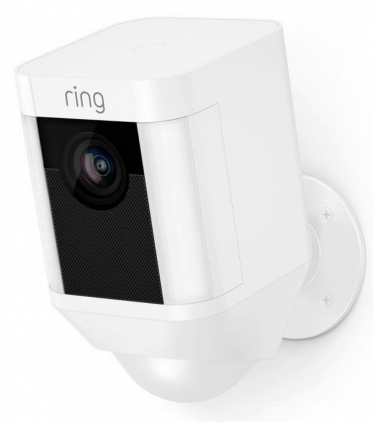
SafeHome.org may receive compensation from some providers listed on this page. Learn More
We may receive compensation from some providers listed on this page. Learn More
We tested Ring’s full lineup of indoor and outdoor cameras to help you figure out which is best for you.


Did You Know? We love a Ring camera as much as the next person. But we prefer the new Nest camera ADT sells with its home security bundles. Check out our list of the best home security systems to learn more about ADT and other top brands.
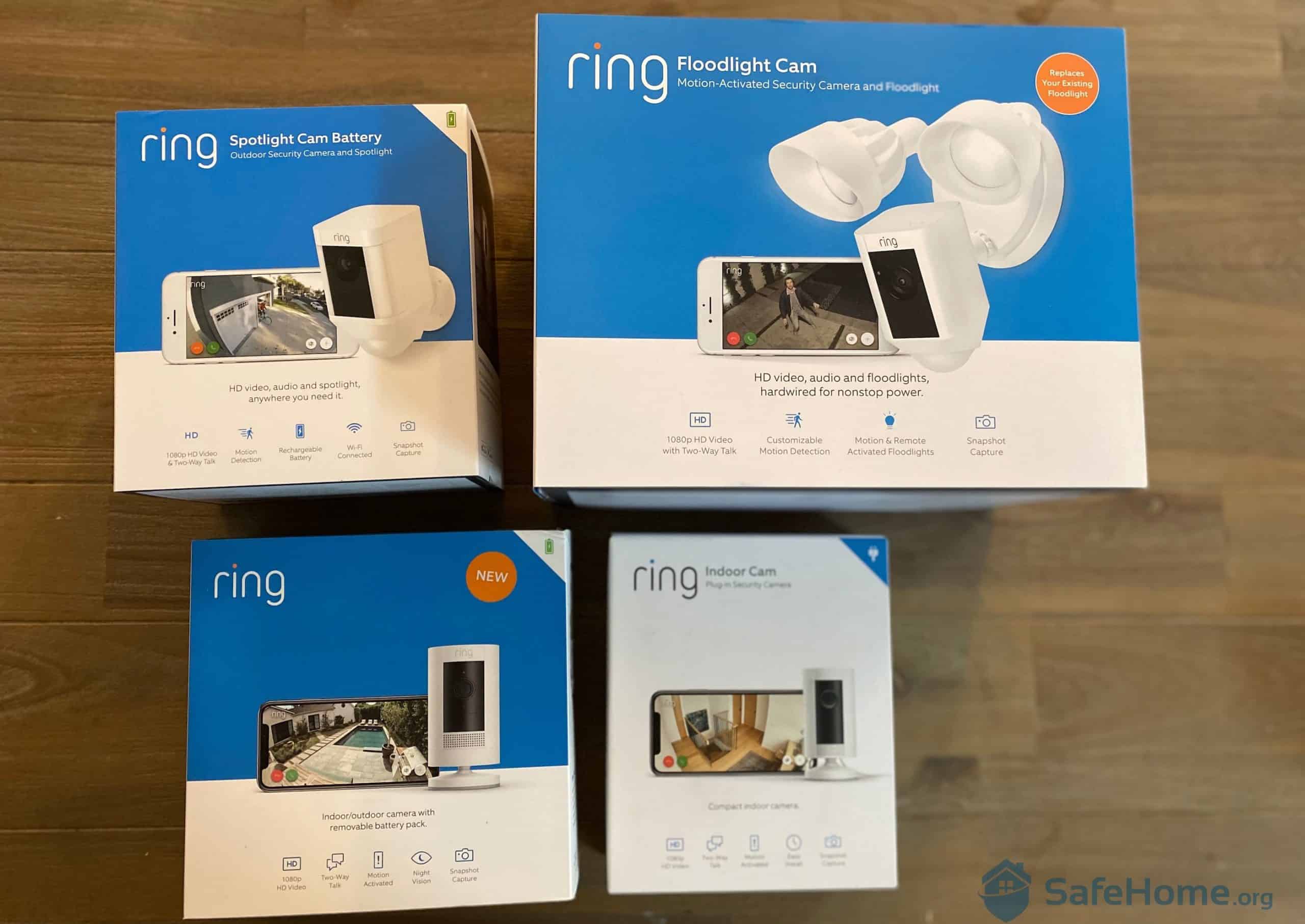
Boxed Up Ring Security Cameras
So you know you want a Ring camera. Good choice. Ring invented the doorbell cam, and has spent the years since then making a name for itself as a premier manufacturer of all types of security cameras. But which cameras are you planning to buy? Do you need an Indoor Cam, a Stick Up Cam, a Floodlight Cam, a Spotlight Cam? Would you like that Indoor Cam in a Pan-Tilt version? How about adding a solar panel to your Spotlight Cam? It’s not enough to know you want a Ring camera. You also have to know which of its many offerings will best suit your needs.
Luckily, you’re not alone. We’ve been testing Ring security cameras since the very beginning, and we stay up-to-date on every new offering and new innovation. This time around, we went the whole hog. We bought different versions of all four basic Ring camera models and spent a couple of weeks putting them through their paces. Now we know everything there is to know about Ring cameras and, more importantly, we can pass that information on to you. No question, Ring remains one of the best home security camera brands. Now you can navigate its many models with confidence.
While Ring is certainly one of the most popular camera manufacturers in the business today, they’re far from perfect. Their equipment can be a little clunky, and their cameras’ resolutions can leave something to be desired. Before you decide on which camera would be best to protect you and your family, you might want to browse through some of our other favorite security brands below. You might also head over to our Ring vs. Arlo head-to-head comparison to get a better idea of what we’re talking about.
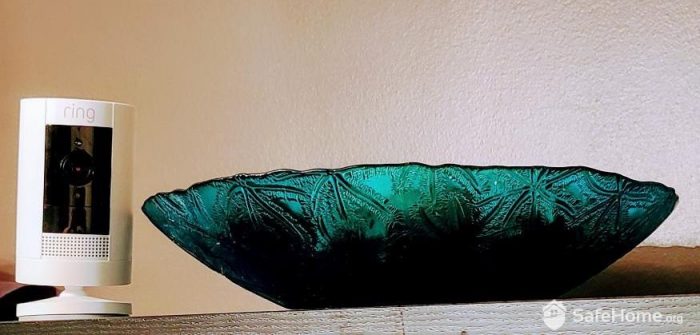
Ring Stick Up Cam
Our first impressions of Ring equipment right out of the box? These aren’t the sleekest cameras on the market, but they’re far from the clunkiest. When we were ordering our package, we were impressed that Ring offers color options. Most camera companies only offer one, and it’s usually either black or white. Ring’s most basic cameras, like the Stick Up and Indoor Cams, come in either black or white, but some devices are available in bronze and graphite too. We opted for white as it fit our home’s aesthetic best.
Even more important to us than style is how easy it is to install home security equipment. We had no problems with Ring on that score. The company made its name by offering DIY-installed systems, and it knows what it’s doing. Everything went smoothly. Not that smoothly isn’t the same as quickly. It took us a full 30 minutes, for instance, to install our hardwired floodlight camera.
Hardwired requires turning a few screws and figuring out which wires go where. Of course, we also took the time to shut off our electricity. That’s a crucial step you can’t skip. Plus, this was an outdoor camera, and it’s always important to take your time placing your outdoor cameras. You want to maximize coverage. In fact, the process can get a lot more complicated if you’re trying to install one of these cameras on a brick wall. Luckily, we didn’t have that problem, but there’s absolutely no shame in hiring professional installers if you need them.
And, we can report that Ring’s simpler cameras were simpler to set up. In fact, all three of the other models took us fifteen minutes, total.
The Ring Stick Up Cam2 (pictured above), for instance, was ready to go right out of the box. You even get to choose where to use the camera with the provided battery or as a wired (plug-in) device. We opted to use it with the provided battery so we didn’t need to place it near an outlet. You also have choices when it comes to placement – hang the camera on a wall or simply place it on a flat surface.
Ring offers several iterations of their Stick Up Cam, as well, including battery-powered models, solar models, a plug-in version with Pan-Tilt functionality, and the Stick Up Cam Elite, which, with an available adapter, works through PoE (Power over Ethernet).
>> Related: The Best PoE Security Cameras
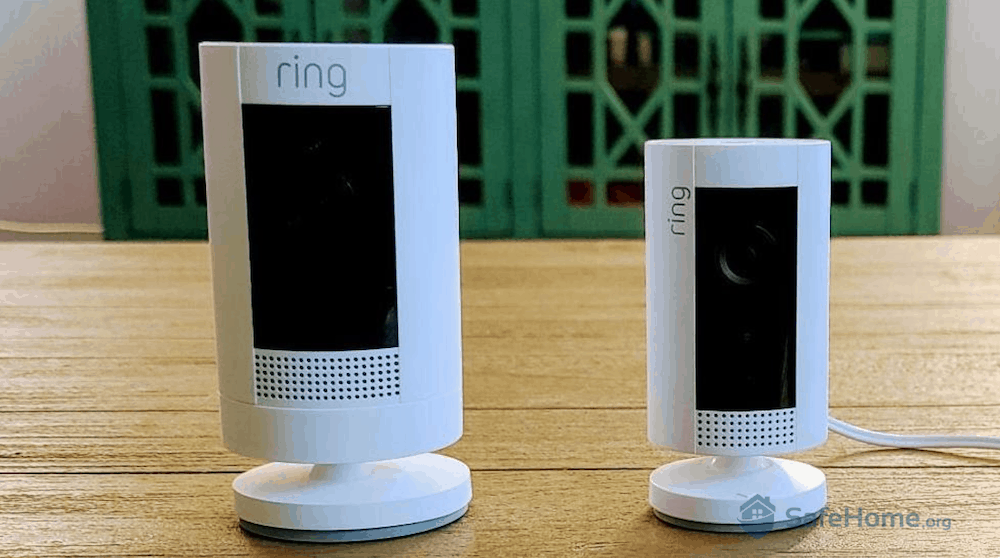
Ring Stick Up Cam (left) compared to Ring Indoor (right)
Did You Know? PoE stands for Power over Ethernet. With PoE devices, one cord connects to the internet and provides power.
Ring’s indoor camera is almost identical to the Stick Up Cam, as you’ll see in the image above, with two notable exceptions: The Indoor Cam is smaller and requires a power cord.
The power cord is pretty short at only 6.5 feet. That limits how far away you can place the camera from a power outlet – without an extension cord, anyway. We went with the battery-powered Stick Up Cam. Cords just don’t go with the look of our apartment. We do give Ring credit for its wide range of choices and we appreciate the lower price point of the Indoor Cam.
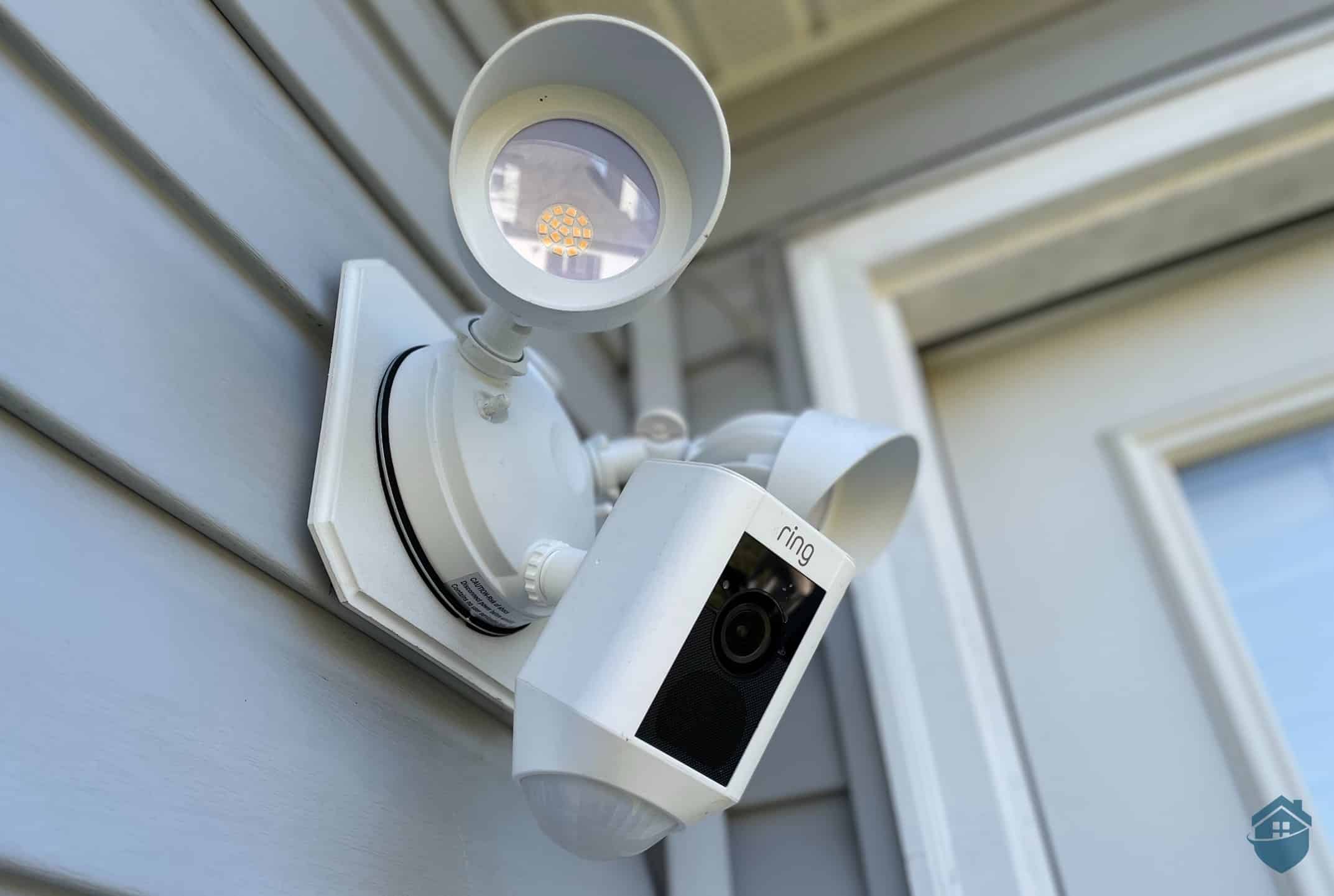
Ring Floodlight
Those are the only drawbacks I ran into installing Ring cams; otherwise, you’re going to get the same easy setup and installation as many wireless security cameras available today.
Beyond installation, let’s explore the ins and outs of each camera in Ring’s suite, starting with the Stick Up Cam.
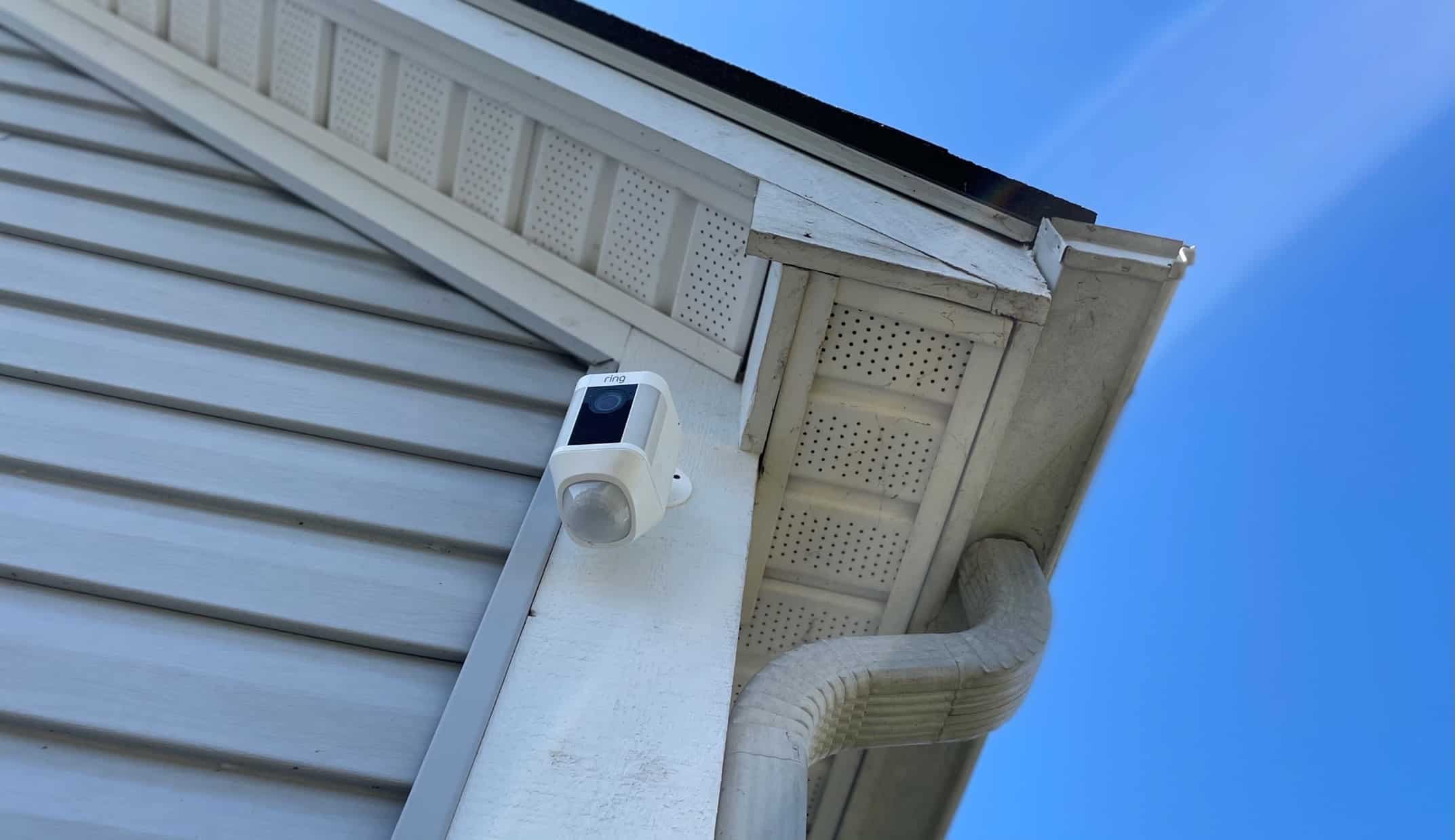
Ring Spotlight
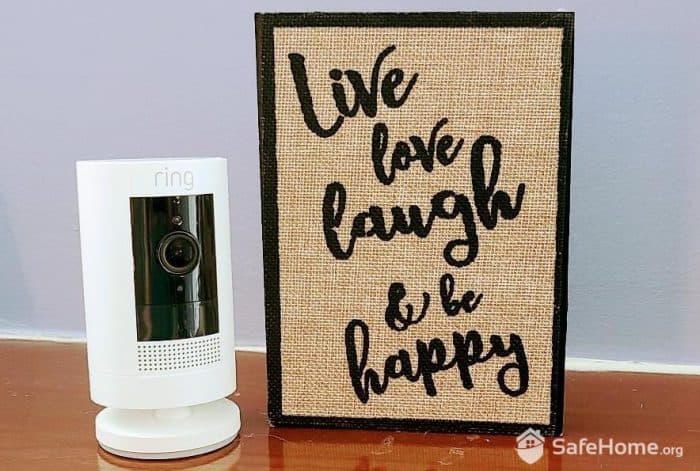
Ring Stick Up Cam
While Ring doesn’t have the feature set of Google Nest’s Cams (see our full Google Nest Cam review here), their cameras are reliable across the board. There’s a reason why they’re one of the top-ranked security camera brands out there. The Ring Stick-Up Cam is a great example.
FYI: Looking for a versatile camera at a reasonable price? Check out our in-depth Ring Stick Up Cam review.
The Stick-Up Cam is designed to be both dependable and versatile. It isn’t the most technologically sophisticated camera on the market. For instance, it doesn’t have facial recognition like Nest Cams do, and it can’t tell people apart from pets like Arlo cameras can. If you’re looking for a workhorse, though, a camera that will reliably keep you safe, day in and day out, the Stick Up Cam is a great investment. You can count on it to detect movement, provide you with real-time alerts, and give you access to live audio and video feeds any time you want. If you have a cloud storage subscription or a professional monitoring plan, the Stick Up Cam records video so you always have a record of what happened. In short, it has all the core features you could want in a home security camera.
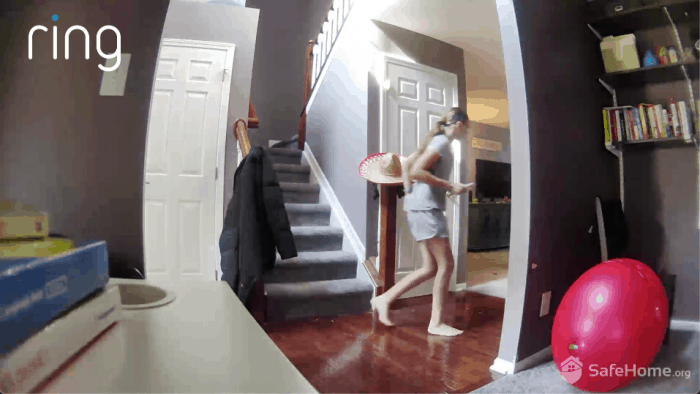
Ring Stick Up Cam live view
Since it can be battery operated or hardwired, one of the Stick Up Cam’s biggest strengths is its flexibility. For starters, you can choose how you use it: battery-operated or hardwired mode. That’s handy for experimenting with different mounting positions. You always want to take the time to determine your best vantage point. That said, you can also set this camera to monitor a single target, like the cat who always knocks over your houseplants or that package thief who’s been spotted in your neighborhood.
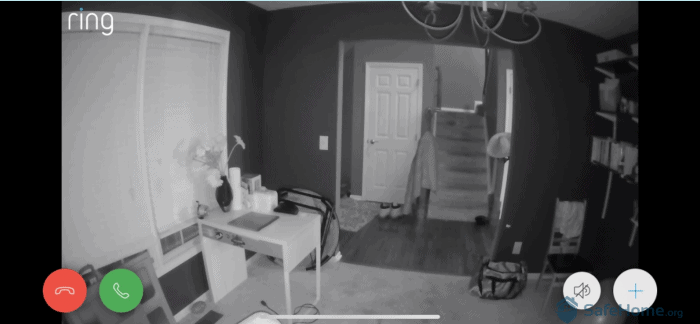
Ring Indoor Cam Night View
We weren’t terribly impressed with the Ring Stick Up’s field of view. 110 degrees might be OK if you have small rooms, but we’ve got an open floor plan, and there’s just no position that allows us to see everything. The Pro version has a slightly expanded field of view – 139 degrees, and with a little ingenuity is is possible to play with angles and positions to get the most out of this camera. Still, you can’t set it to pan over a room like a Reolink E1 camera, for example. And ultimately a limited field of view means that it’s possible, with a little planning and foresight, for a home invader to avoid detection altogether.
Pro Tip: Reolink cameras don’t have the cache of a Ring cam, but they’re actually really impressive devices in and of themselves. Learn more about the brand in our full Reolink camera review. If you’re looking for an outdoor cam with pan-and-tilt technology, check out our latest Reolink E1 camera review.
Okay, I feel that we have to put this here. Ring markets the Stick Up Cam as an indoor/outdoor camera. It’s easy to assume that the camera is weatherproof because it can work outdoors, but that’s not the case. We checked the manual and found that it’s IP X5 rated.
The ‘X’ signifies that it’s not dust-proof at all. That means dust and small particles can enter the casing and potentially ruin the electronics inside. The ‘5’ means it’s at least a little bit water-resistant. It’s sealed from water jets from any direction, so it can at least resist rain. We wouldn’t risk it though, not with that IP X5 rating. If you’re going to place the Stick Up Cam outdoors, we recommend finding a covered area like a patio or porch or under an eave.
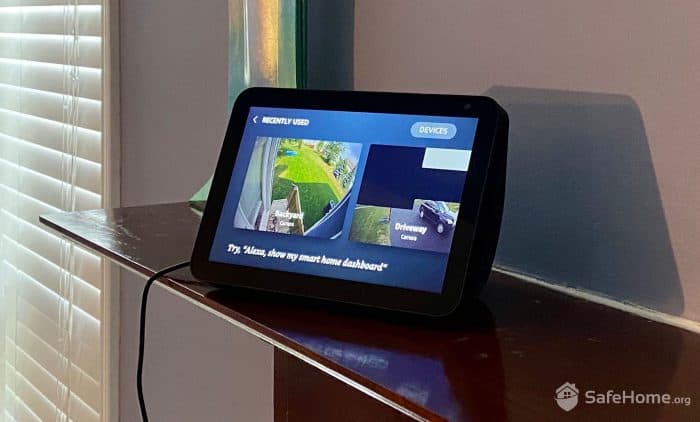
Ring dashboard on the Alexa Show
Here’s some good news: It’s really easy to integrate a Ring camera into any Amazon smart home ecosystem. (We covered the full step-by-step Ring home automation process here, if you’re interested.) It’s not much more than popping over to the Ring app’s Alexa tab and following the prompts. With the Stick Up and all the other Ring cameras, simply pull up the full Ring dashboard using voice commands like, “Alexa, disarm my driveway camera.” If you’re a big fan of Alexa and using voice commands, we recommend Ring as one of the best security camera brands for you.
FYI: If you’re interested in building or adding to a smart home – Alexa or otherwise – we recommend visiting our full home automation guide first.
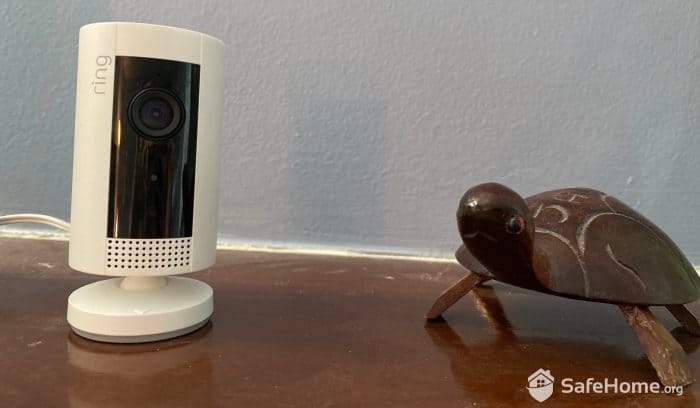
Ring Indoor Camera
When it comes to the industry’s top-rated indoor cameras, sometimes less is more. The Ring Indoor Camera is the smallest in Ring’s lineup, standing less than 3 inches tall without its support stand. It comes packed with plenty of features, though. Plus, it provides the same video feeds as much larger cameras without taking up nearly as much space. After all, security matters, but so does decor.
FYI: Interested in a Ring Indoor Cam? Learn how it measures up against other popular options in our full Ring Indoor Cam experience.
Let’s talk more in-depth about the pros and cons.
No matter what company you buy your cameras from, you should expect a certain amount of glitches and delays, especially if you’re working with wireless devices. You have to know right up front that Wi-Fi is never 100 percent stable. App updates, high-volume traffic, and plain old slow-downs can all affect a device’s performance, and when you’re dealing with video cameras, even a small glitch can make it difficult to see what’s in a feed. Within those parameters, though, Ring cameras are designed to work with Wi-Fi, and we found that all of our devices provided a clear, reliable video stream.
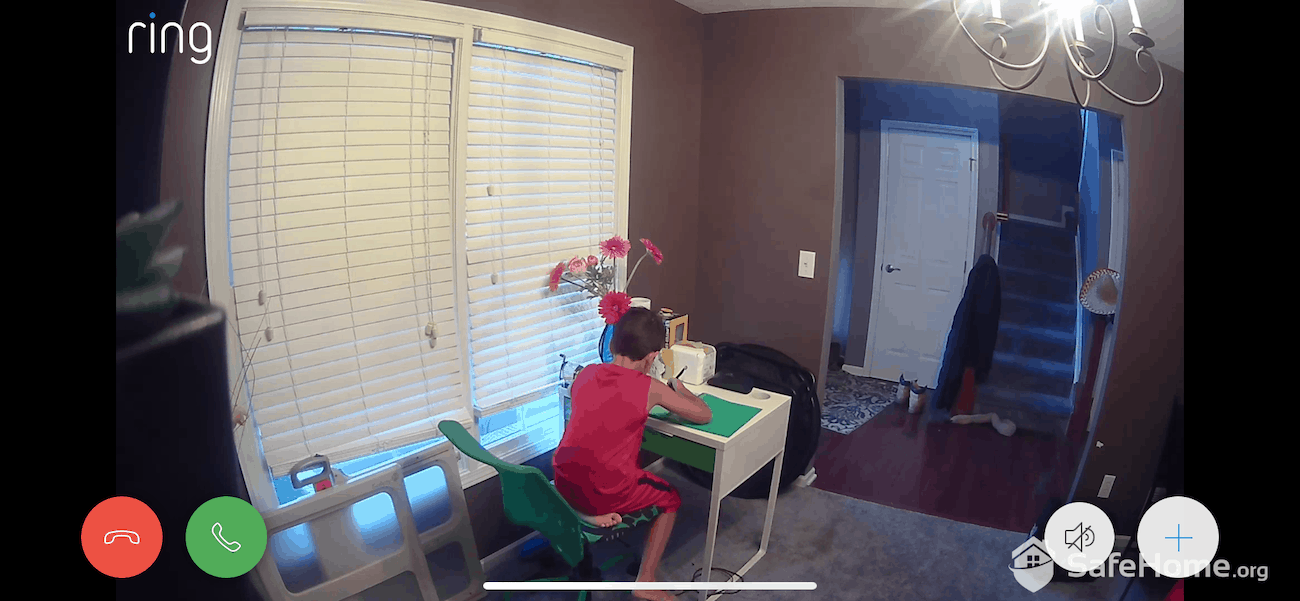
Ring Indoor Cam Video Quality
It helps that Ring cameras all utilize 1080p HD resolution. Are there cameras out there with higher resolution? Yep. Both Loex and Vivint offer 4K models that let you count the hairs on your dog’s tail. Really, though, how often do you need to do that? 1080p is the industry standard and it creates a crisp, clear view of whatever you’re looking at, from porch pirates to what your dog is doing to your couch cushions while you’re at work. (Intrigued by Vivint? Catch up on our latest Vivint Home Security analysis.)
As mentioned above, the power cord that comes with Ring Indoor is only 6.5 feet, so you might need to get creative with placement. But once everything is said and done, you’ve got a great little camera that you can set up and basically forget about. Through the Ring mobile app, you can set the indoor cam to record clips while you’re out of the house. And when you’re home, you can turn recordings off for privacy, or adjust motion settings to receive fewer alerts. It’s Ring, so you know you’ll get plenty of flexibility.
The word “cheap” has negative connotations. When you buy a product that doesn’t work right, you might call it “cheap.”
At $59.99, the Ring Indoor Cam is the cheapest camera in Ring’s lineup, both in terms of price and in terms of reliability. That said, you’re still getting that impressive 1080p video quality in every recording, even at night. You also get access to Ring’s powerful cloud-based network. In short, you’ll get no complaints on the price of this camera here. It’s “cheap,” sure, but you probably don’t need premium-level features in a camera like this. It’s for indoor use, after all. And as compensation, you’re also not going to pay premium-level prices. That’s how it goes in this industry, more or less.
For context, let’s take a look at the Ring Indoor Cam’s price against some of its leading competitors.
| Indoor Camera Model | Manufacturer | Price |
|---|---|---|
| E1 Pro | Reolink | $45.09 |
| Indoor Cam | Ring | $59.99 |
| Indoor Wi-Fi Security Camera | Lorex | $49.99 |
| Essential Indoor Camera | Arlo | $59.99 |
| SimpliCam | SimpliSafe | $99.00 |
| Indoor Cam | Nest | $99.99 |
Did You Know? If you’re really into the slim and simple theme, check out Blink, another Amazon brand similar to Ring. They won’t blow you away with features, but in our tests of the Blink camera system, the cameras looked nice and installed in a snap.
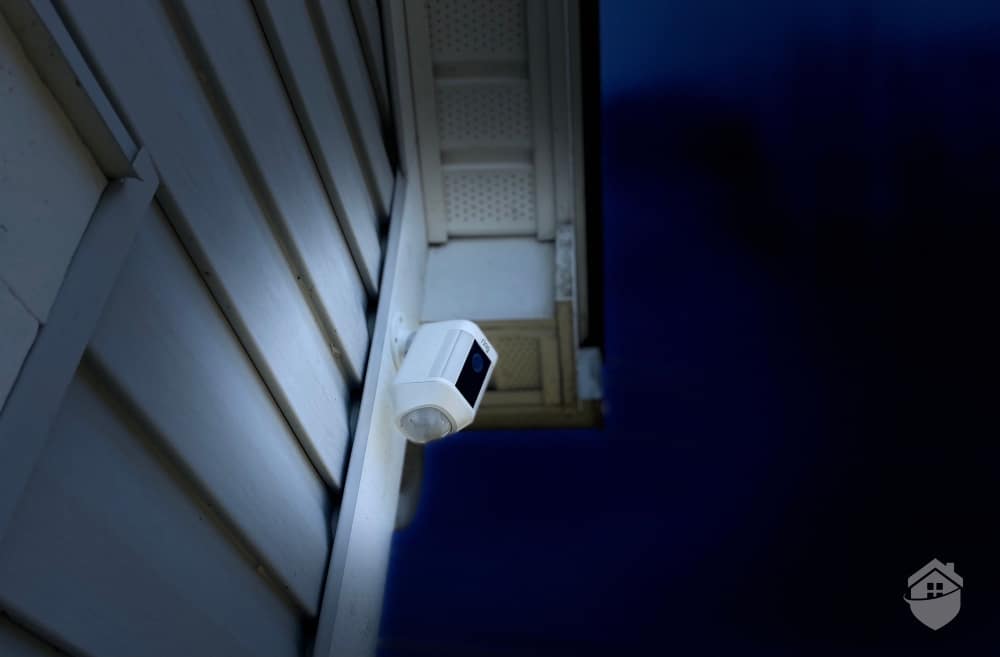
Ring Spotlight Camera at Night
Spotlight Cam is Ring’s outdoor camera for all those areas outside the house you need to illuminate and capture at a moment’s notice. Note that it comes in wired or wire-free, black or white finish, and you can now use this camera (and all the other Ring cams) with a Ring solar panel for an even more convenient way to secure your home’s exterior.
FYI: Looking to shed some light on would-be burglars and thieves? Read more about our full Ring Spotlight Cam experience here. We also talk about the different models of the Spotlight Cam, including Spotlight Cam Plus and Pro.
Beyond that, you’ll find the same features in Spotlight Cam that Ring packs into its other cams: 1080p HD resolution, advanced motion detection, and two-way audio with noise cancellation. When we tested this camera, the motion-activated spotlight helped us make sense of the occasional mysterious activity lurking around our property. That’s news you can use – especially if your neighborhood has a history of (or a recent uptick in) break-ins. Combined with Ring’s Neighbors4 feature, the Ring app that acts as a neighborhood watch, you’ll have more insight than ever on what’s going on around your property.
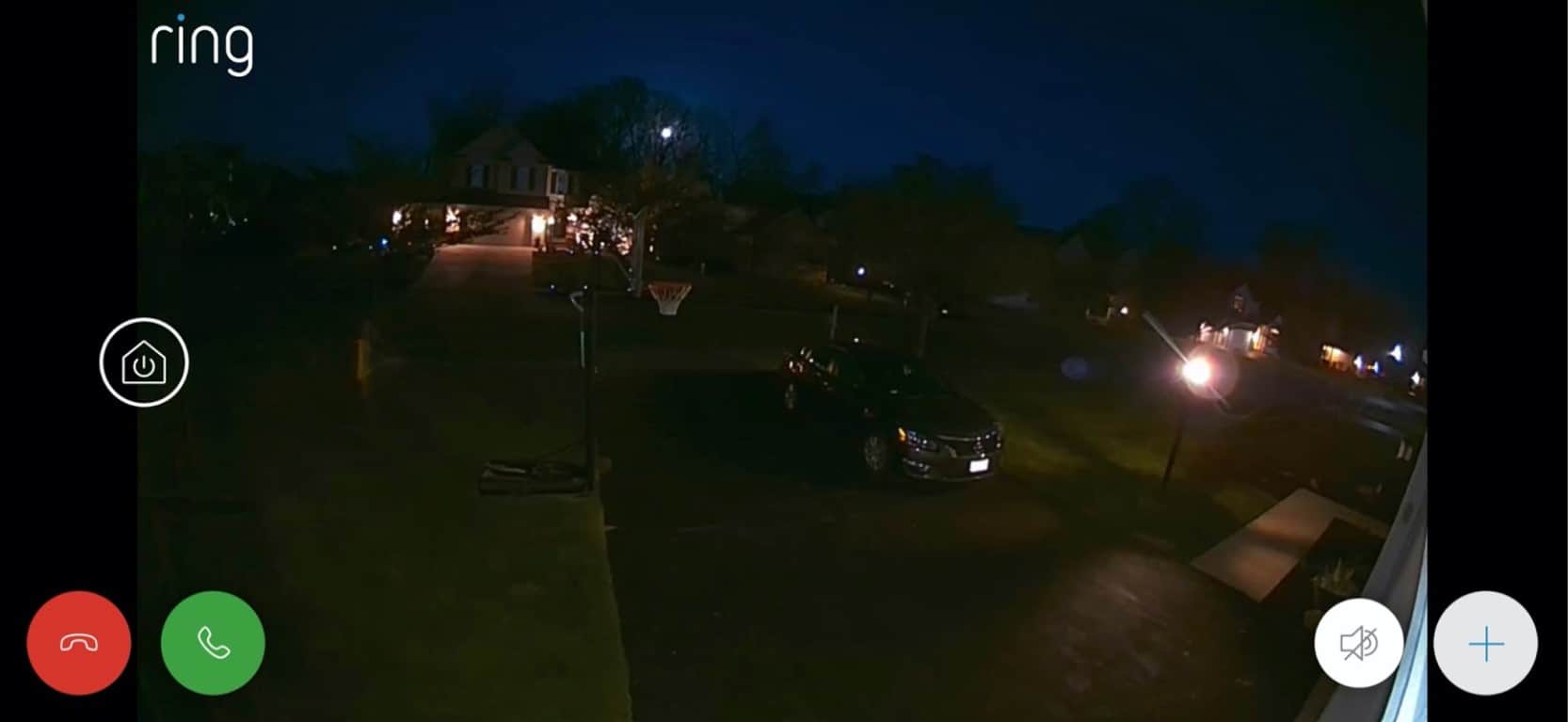
Ring Spotlight Night View
The Spotlight Cam provides great nighttime images, so long as the spotlight itself is on. Again, you get 1080p HD resolution, as you do with all Ring cameras, and the Spotlight Cam can see well beyond your front porch. As long as that LED spotlight is on. Otherwise, we wouldn’t recommend this device for night viewing. Once you’ve set the Spotlight Cam up where you want it, it’s important you set the the light to come on any time the camera’s motion detection is activated. Of course, it’s also worth pointing out that the spotlight isn’t just handy for deterring potential burglars. Unlike the Ring Floodlight, it’s not going to overwhelm you with light when it comes on, so you can use it to find your way up the driveway when you’ve come home after work with bags of groceries in your arsm.
Pro Tip: If you’re not a Ring loyalist, the Reolink Argus 3 Pro makes a solid Spotlight Cam alternative that’s a bit easier on the pocketbook. Visit our review of Reolink Argus 3 Pro to learn more.
With a Ring Spotlight perched over a driveway or garage (like mine is positioned in the above image), you might start getting a lot of unwanted or “nuisance” alerts from cars and pedestrians. If you’re self-monitoring your cameras – which the Ring app makes really easy to do – the best way to avoid unwanted alerts is to draw a privacy zone over part of the screen to block out the area you don’t want motion to trigger. As in the scene pictured below, “that kind of motion” was a car driving past our house, which happens about a gazillion times a day.
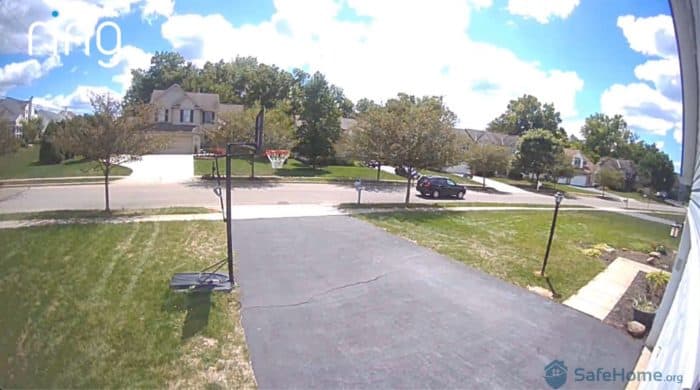
Ring Motion Activation
If you encounter this, we suggest setting the motion sensitivity slider in the Ring app to a lower motion sensitivity. In addition, though, you can pop into motion zones and black out part of the scene so the camera doesn’t detect motion there. Those two adjustments combined should do the trick; if you’d rather avoid tinkering too much with the camera during busy times, you can always set a schedule to turn motion recording on and off. (Hint: This also saves battery life.)
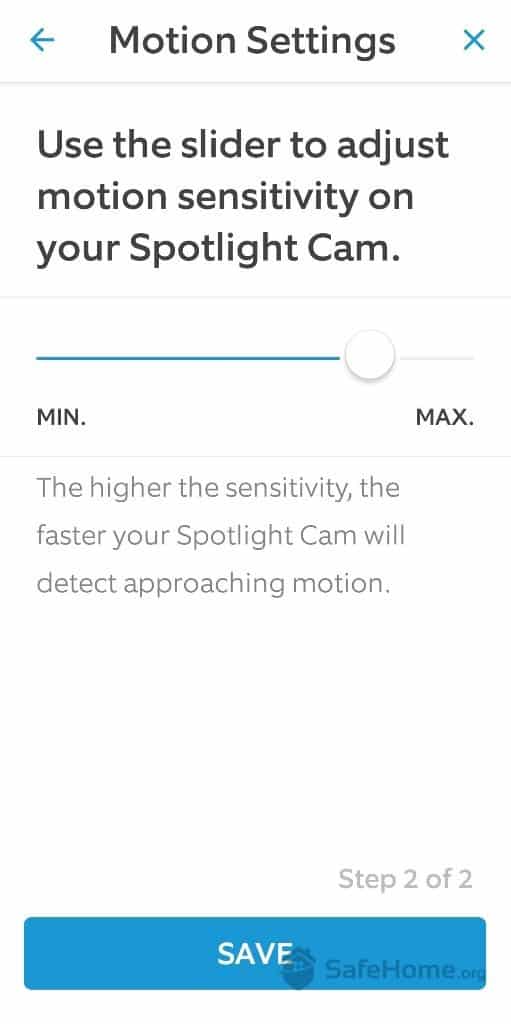
Ring Motion Sensitivity Slider
The plug-in Spotlight Cam Plus currently costs $169.99, a great price for a camera with all of its features. Note that you can purchase a solar panel of this camera as well. That package costs $30 more – $199.99 – but it can save you money on electricity and batteries in the long run. And after all, who wants to spend all their time going up and down a ladder to keep equipment charged?
FYI: The Ring Spotlight camera tends to go on sale from time to time. Check out our full Ring camera deals and discounts guide for more ways to save on Ring devices.
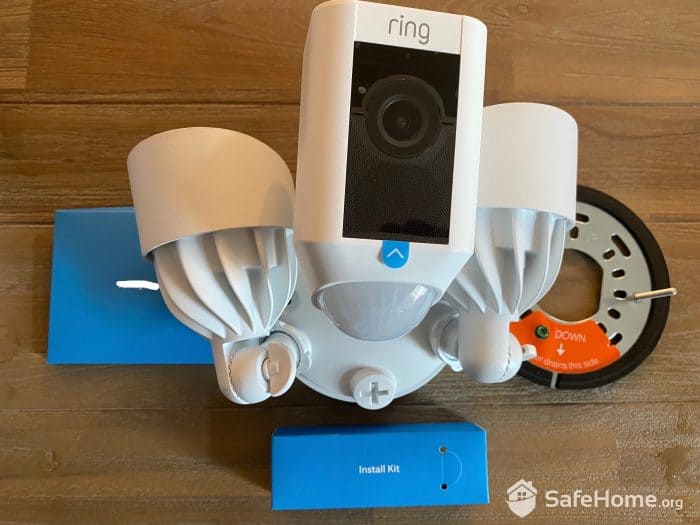
Ring Floodlight Cam
Nestled firmly between two super-powerful LEDs, the Ring Floodlight Camera was the almost-perfect fixture to complement my outdoor decor. Ring also offers this model in a variety of finishes, including graphite and bronze, if you’re looking to get away from the more standard black or white design.
Did You Know? Bright LED lights can serve as an effective crime deterrent. With this in mind, read about Ring’s most robust camera/light combo in our latest Ring Floodlight Cam review.
It’s important to note, though, that Ring is not the only company to make a floodlight camera. When it hit shelves in early 2020, the Arlo Floodlight Camera became a solid contender, but Arlo is battery-powered, while Ring’s floodlight camera is wired.
For our home, however, Ring’s hardwired setup worked best. It was the perfect opportunity to replace an old light fixture that was a little past its prime, with a shiny new floodlight-camera-in-one.
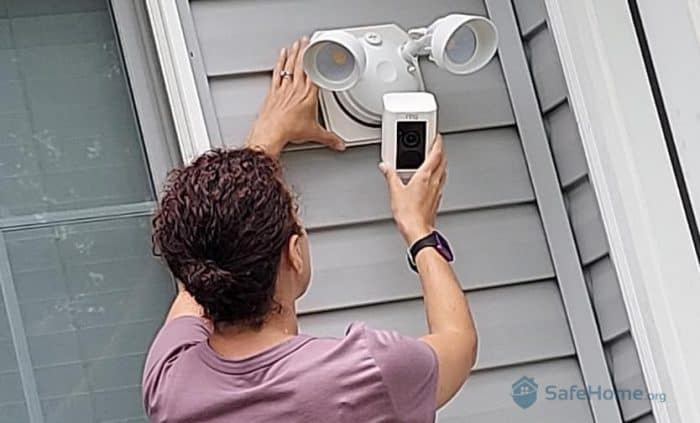
Installing the Ring Floodlight Cam
After thoroughly testing the Ring Floodlight Cam, we’re comfortable singing its praises, simply because it’s one of the strongest lines of defense you’ll have in your home security toolbox. You’re getting unprecedented range, a wide field of view, and a smooth two-way audio feature that can be used in tandem with motion-activated lighting to spook even the boldest of criminals – or just to say hi to a few unexpected visitors.
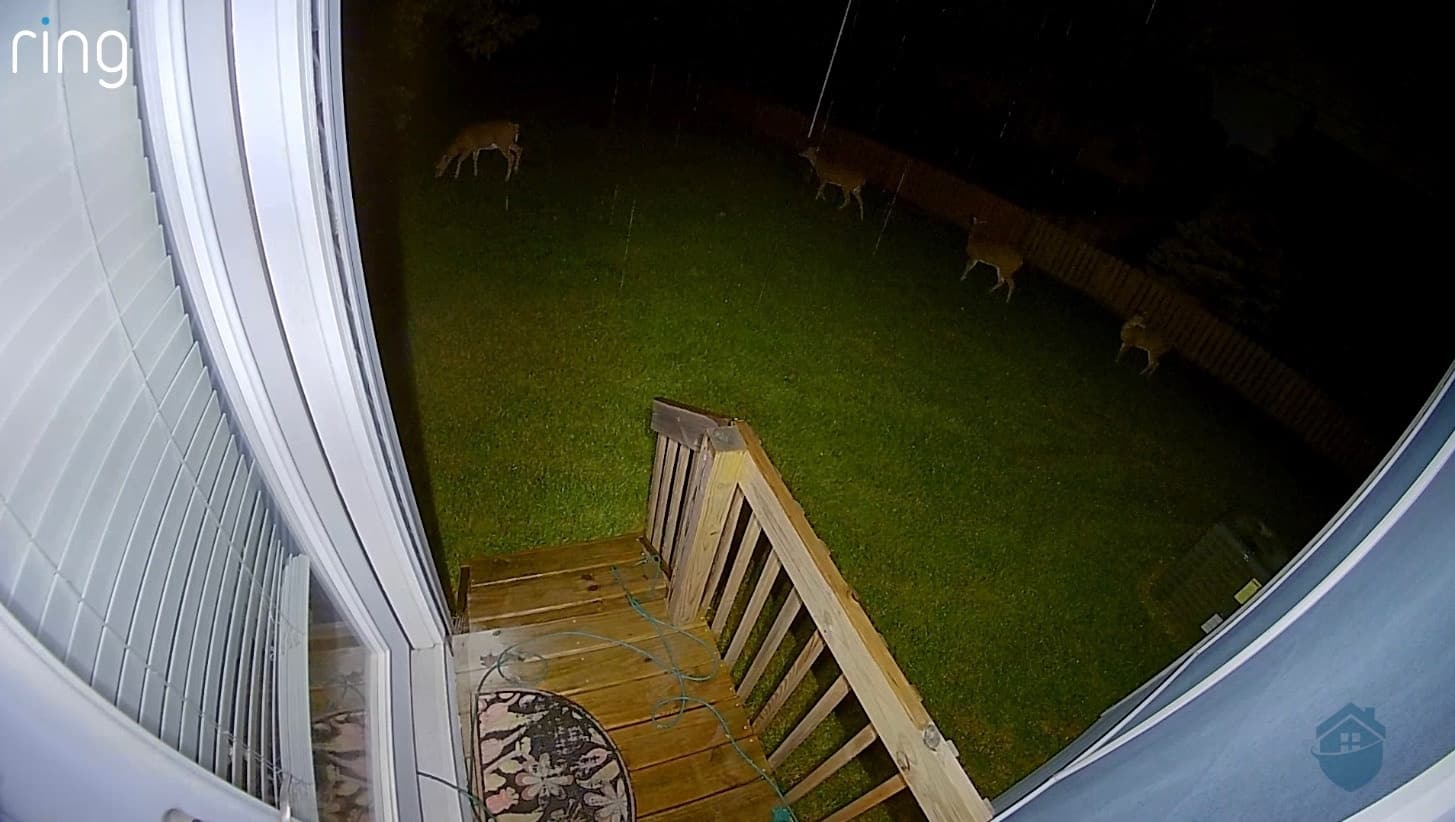
Ring Floodlight Cam Video Quality
There are a few more things you should know about this camera before making your final decision, though, starting with that previously mentioned audio feature:
When it comes to audio on the Floodlight Cam, all was well with the exception of some interference due to background noise, usually on the outdoor end of the conversation.
It’s not the first time we’ve encountered this issue. Ambient noise5 – you know, the kind that happens outside that you can’t control or predict – can make communication difficult at times. But frankly, the issue is minor, and it shouldn’t affect the overall performance.
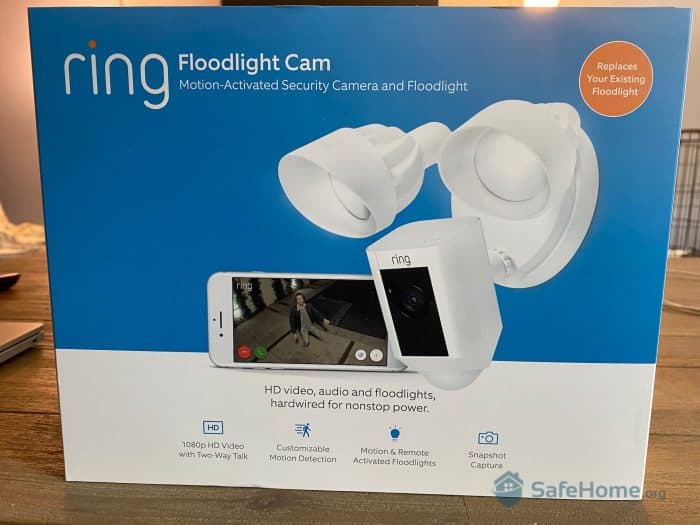
Ring Floodlight Cam Box
Since it’s made for the outdoors, Ring has their floodlight camera locked down with plenty of weatherproof hardware and protection from the outdoors. During our own tests of the device, we watched it sail through an intense late-winter band of snowstorms (you know, just another Ohio “second winter”) without missing a beat. After all that, the Floodlight Cam performed seamlessly and did not incur any damage, which is good, because we’d already thrown out the old light fixture.
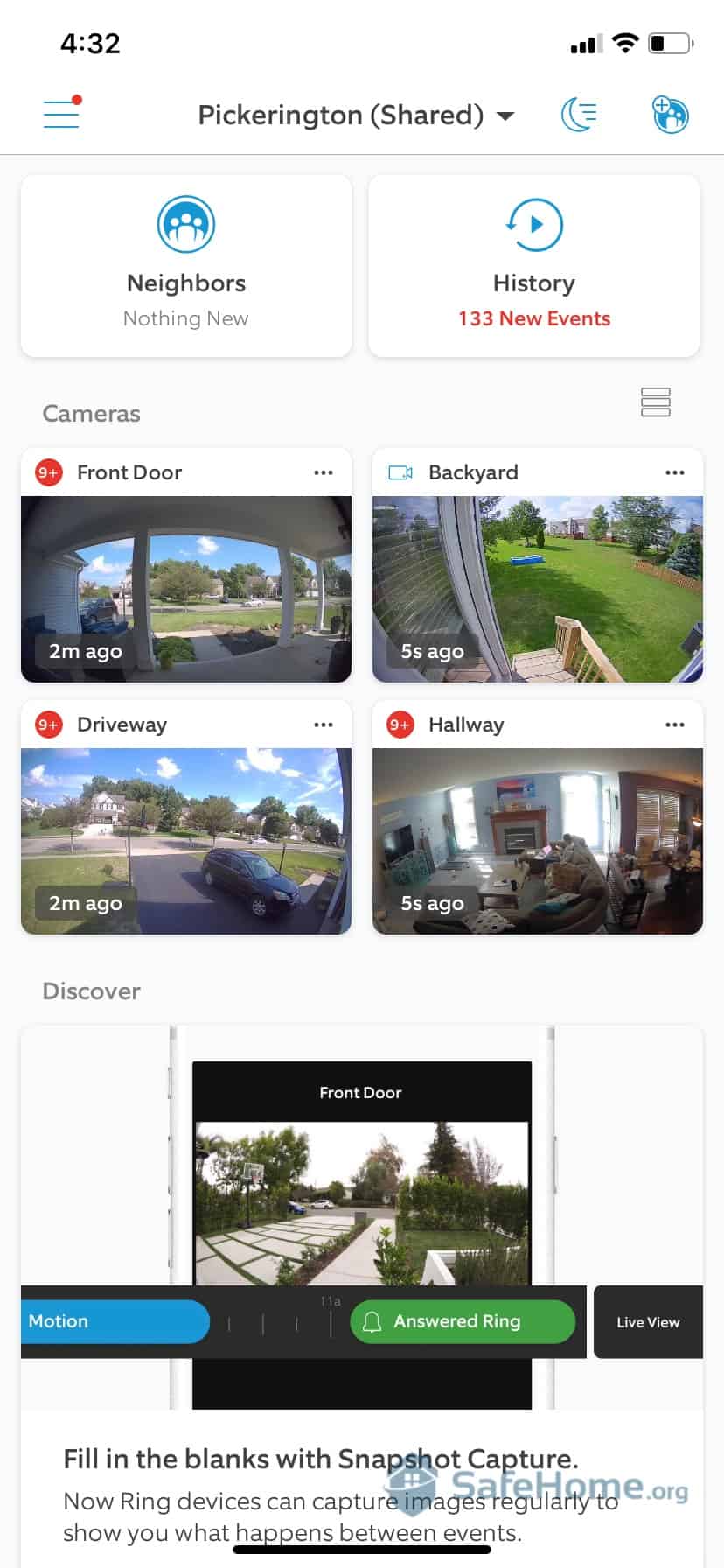
Ring App Homescreen
The best way to get acquainted with any wireless camera is to learn everything it can do through the mobile app. With Ring, you know that’s going to be easy – and it will also help you prepare for the unexpected.
Occasionally, you might find a few rare instances of delay between the time the camera captures motion and the time you receive an alert. Again, that is standard in cameras that work with Wi-Fi, and a bit more common in outdoor cameras than indoor ones. But with a stable Wi-Fi connection, you should have no problem securing your home with a Ring Floodlight.
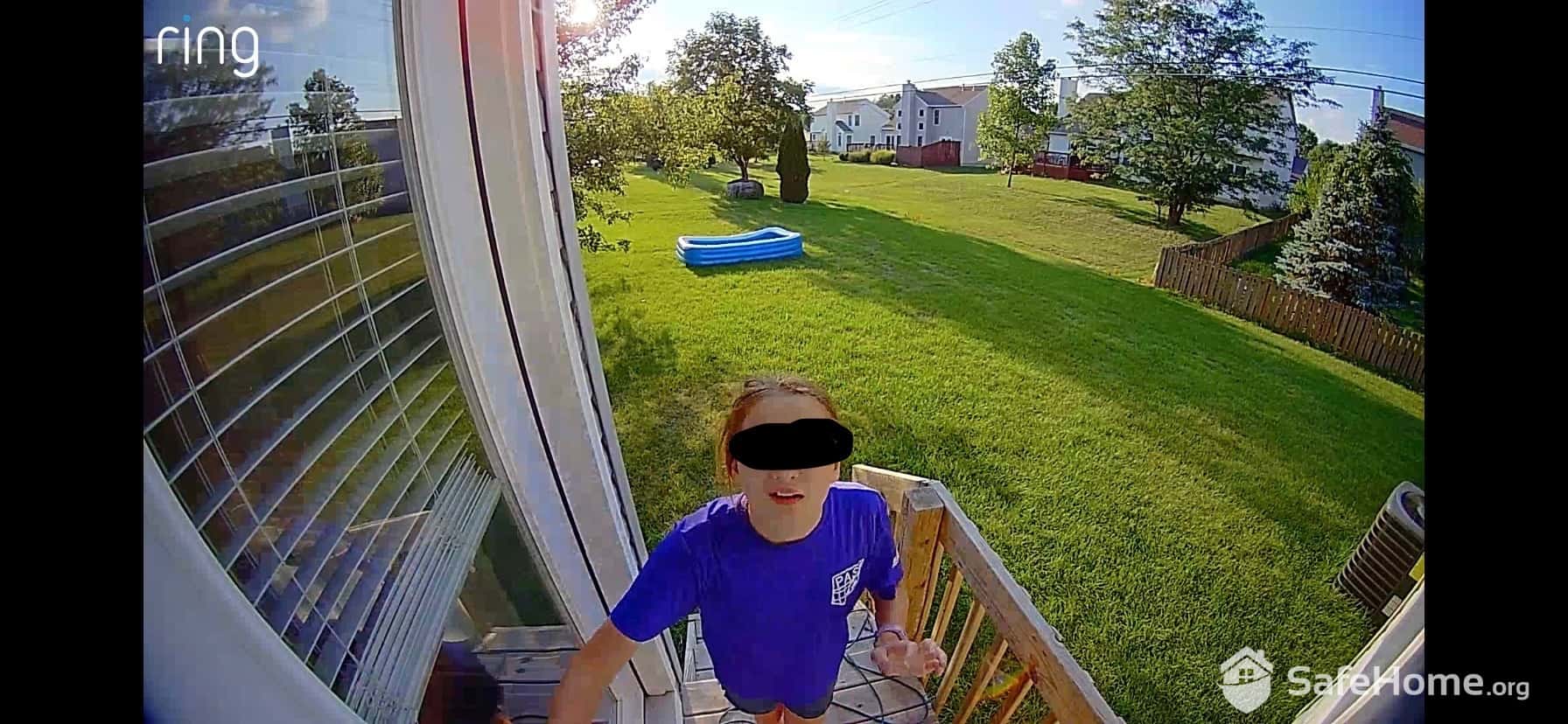
Ring Floodlight Cam Motion Detection
After successful sales of Ring’s first-generation Floodlight Cam, the brand recently added Floodlight Cam Wired Plus and Floodlight Cam Wired Pro. The Pro, I learned, has a couple of advanced features over the original, like 3D motion detection and two-way talk with audio+, as well as a few subtle design upgrades. With a base price of $249.99, it’s one of Ring’s most expensive cameras, but it’s definitely one of the best, too.
Speaking of price, it’s worth mentioning that the Ring Floodlight Cam Plus is another one we’ve seen marked down frequently throughout the year. It regularly retails for $199.99 (you’ll see a bigger breakdown below), but it happens to be a very popular device to snag around Prime Day, too. Look for those and other huge savings in our complete Prime Day home security deals and discounts guide.
With a total of four security cameras – Indoor, Stick Up, Spotlight, and Floodlight – you may find it difficult to choose which one is best for your home, especially if you’re on a budget. So we ranked the cameras based on their security value.
| Ring cameras | Type | Description |
|---|---|---|
| Ring Indoor Cam | Indoor camera | Affordable, lightweight, and easy to set up, but has limited features |
| Ring Spotlight Cam | Outdoor camera | Comes with motion-activated spotlight and is fully- weatherproof, but still affordable |
| Ring Stick Up Cam | Indoor/outdoor camera | Affordable outdoor camera option but not fully-weatherproof |
| Ring Floodlight Cam | Outdoor camera | Powerful motion-activated lights, but can be pricey |
“You get what you pay for.” You’ve surely heard that expression many times, especially if you’ve ever bought home security equipment before. Like buying a car, adding security cameras can be a very personal experience – so you want to get the product that’s right for you.
Luckily, Ring cameras are for the masses. They’re made for the everyday DIY user, and generally not recommended if you’re looking for wall-to-wall home security or 24/7 monitoring. For that, we’d go with a fully wired system like Frontpoint Home Security, or even something from SimpliSafe, a super-DIY setup.
For now, let’s break down how much you should expect to pay for each Ring camera. We also recommend checking out our comprehensive Ring camera package and pricing page for more cost considerations.
| Ring Camera | Features | Price |
|---|---|---|
| Spotlight Cam Pro Battery | Two-way talk, built-in siren, color night vision, 3D motion detection, birds-eye view | $229.99 |
| Spotlight Cam Plus Battery | 1080p HD, motion alerts, motion-activated spotlight, two-way talk, siren | $169.99 |
| Floodlight Cam Wired Plus | 1080p HD, 3D motion detection, bird’s eye view, two-way talk, siren | $199.99 |
| Stick Up Cam Battery | 1080p resolution, color night vision, advanced motion detection, customizable motion zones | $99.99 |
| Indoor Cam | Two-way audio, live view, color night vision | $59.99 |
| Stick Up Cam Pan-Tilt | Pan and tilt functionality, 1080p resolution, color night vision, advanced motion detection, customizable motion zones | $129.99 |
Pro Tip: Ring’s cameras are almost always on sale. To figure out which cameras can give you the most value, you need to know Ring’s current sales. That’s why we put together a guide to the best deals on Ring cameras so you can figure out if now is the right time to buy the cameras you need.
If you’re working on a budget, you can use your Ring cameras to monitor your home for free. Both come with motion sensors and send you an alert when they detect anything happening at home. Then, you can pull up live footage to decide whether or not you need to take action. If that sounds useful to you, you might consider one of Ring’s video storage plans. You can add storage to a single camera for $4.99 a month, or purchase the $10 a month Protect Plus Plan to get storage on an unlimited number of devices.
Finally, you can also add 24/7 professional monitoring protection through Ring’s Protect Pro plan, but the monitoring applies only to the Ring Alarm. Read more about that system in our full Ring Alarm review. Ring won’t monitor your cameras with this plan. We recommend professional monitoring though since you can’t be sure you’ll always be free when you get an alert. Plus, Ring makes it relatively painless to go this route by offering the Protect Pro Plan for just $20 a month. That’s some $10 cheaper than SimpliSafe’s plan.
| Ring Subscriptions | Included Free | Ring Protect Basic | Ring Protect Plus |
|---|---|---|---|
| Instant Mobile Alerts | Yes | Yes | Yes |
| Live Video Streaming | Yes | Yes | Yes |
| Two-Way Talk | Yes | Yes | Yes |
| 180-Day Video History | No | Yes | Yes |
| Video Saving/Sharing | No | Yes | Yes |
| Snapshot Capture | No | Yes | Yes |
| Extended Warranty | No | No | Yes |
| Add 24/7 Professional Monitoring | Not Available | Not Available | +$10 per month |
| Monthly Price | Free | $3.99 per month | $9.99 per month |
| Yearly Price | Free | $39.99 per year | $100 per year |
Now, if you want professional monitoring, Ring does things differently than most competitors. They offer it as an add-on. It requires a Ring Standard subscription and adds $10 per month to your bill for a total price of $19.99 per month.
They also offer a premium monitoring service that’s similar to SimpliSafe’s Fast Protect monitoring. Ring calls it their Virtual Security Guard service. It enables Ring’s monitoring agents to actively review your live video feeds during events and use your camera’s two-way talk to deter criminals. That service comes at a hefty price of $99 per month which is more than SimpliSafe charges but less than Deep Sentinel.
What started as a simple company looking to disrupt the home security market with its Ring Video Doorbell has grown into a security camera powerhouse. Ring has become a customer favorite in the industry, and it’s not hard to see why. Our own extensive testing of Ring’s outdoor and indoor security cameras convinced us that these cameras are easily on par with similar offerings from companies like Arlo and Google Nest. They’re reliable, come with a useful range of features, and available at a reasonable price.
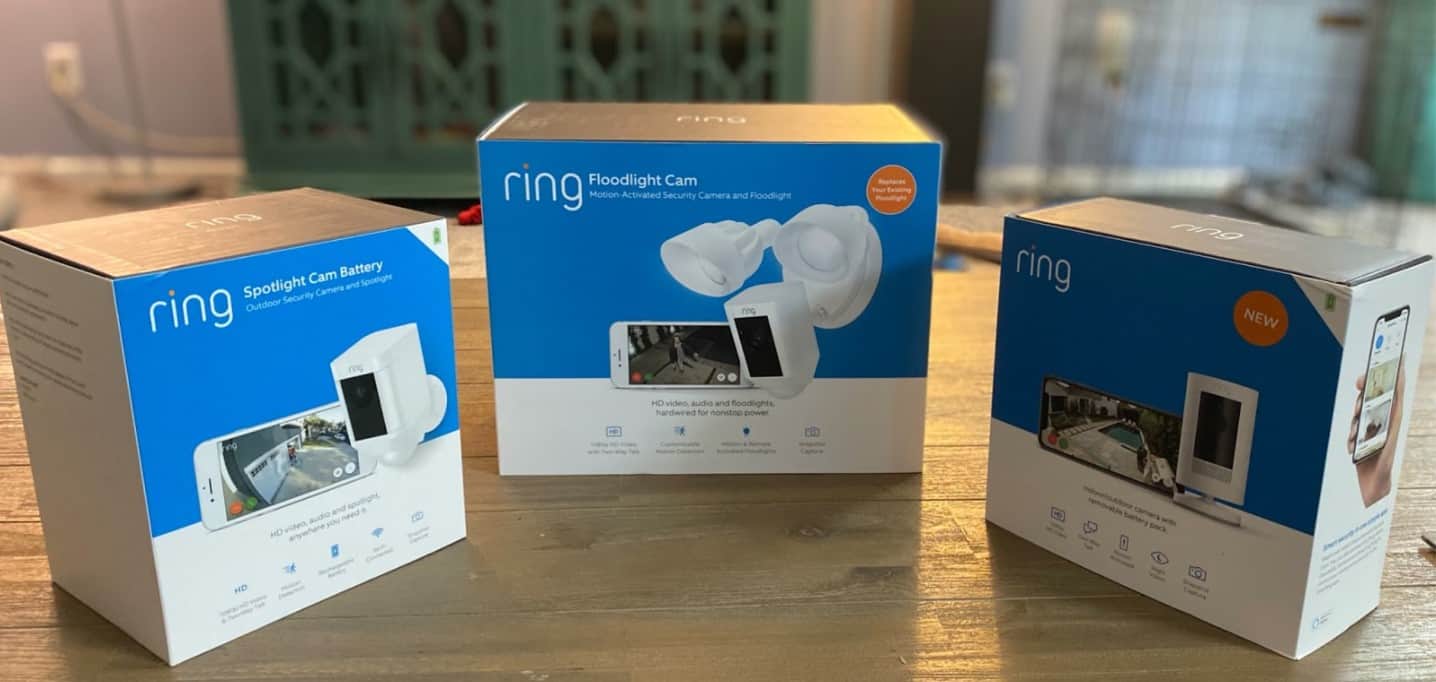
Ring Cameras Lineup
Gloomy Midwestern thunderstorms are no match for the Ring Floodlight. The camera is made to hold up in harsh weather like storms, wind, and rain.
Yes, with some exceptions. Ring cameras work with Amazon Alexa for hands-free voice control and video streaming on an Echo Show or Fire TV. Their compatibility with other ecosystems like Google Assistant and IFTTT are somewhat limited.
The two LED floodlights on the Floodlight Camera put out 1,500 lumens each, while the Spotlight Cam’s LEDs are 350 lumens. That makes Floodlight Cam about 4-5x brighter than the Spotlight Cam.
The Indoor Camera is susceptible to water damage and is not approved for outdoor use. The Stick Up Cam, on the other hand, is weather-resistant, but not fully waterproof, so keep that in mind when locating the camera.
A mixed bag, in my experience. You might not have the easiest time getting questions answered using Ring’s live chat, though it’s nice how easily accessible the chat feature is within their app. Other times, you’ll have better luck calling and speaking to a human.
Kim, E. (2018, February 27). Amazon buys smart doorbell maker Ring for a reported $1 billion. CNBC.
https://www.cnbc.com/2018/02/27/amazon-buys-ring-the-smart-door-bell-maker-it-backed-through-alexa-fund.html
Business Wire. (2018, September 20). Introducing Ring’s First Indoor/Outdoor Security Cameras: Ring Stick Up Cams.
https://www.businesswire.com/news/home/20180920005805/en/Introducing-Ring%E2%80%99s-First-IndoorOutdoor-Security-Cameras-Ring-Stick-Up-Cams
Hurst, A. (2020, July 9). Nearly 1 in 5 Consumers Experienced Package Theft Since the Start of Quarantine.
https://www.valuepenguin.com/nearly-one-in-five-consumers-experienced-package-theft-since-start-of-quarantine
Business Wire. (2018, May 8). Ring Makes Successful Neighborhood Watch Network Available to Everyone With the Launch of the Free Neighbors App.
https://www.businesswire.com/news/home/20180508005836/en/Ring-Makes-Successful-Neighborhood-Watch-Network-Available-to-Everyone-With-the-Launch-of-the-Free-Neighbors-App
Science Direct. (2021). Ambient Noise.
https://www.sciencedirect.com/topics/earth-and-planetary-sciences/ambient-noise